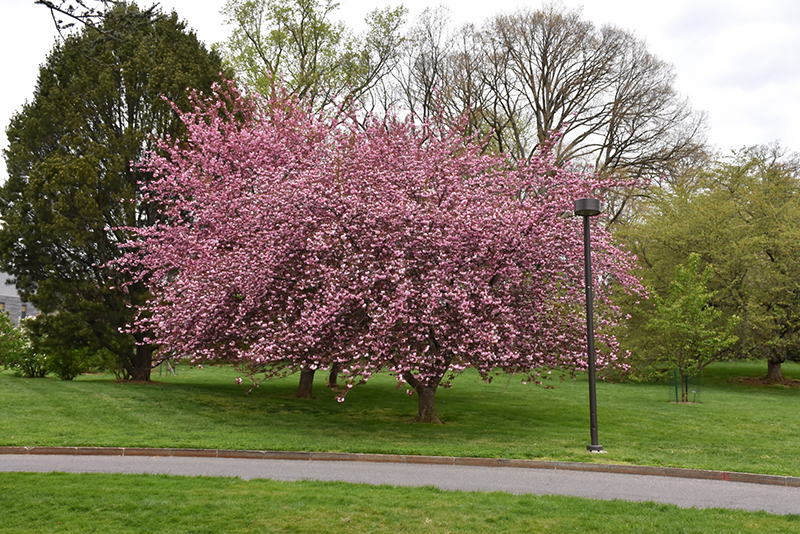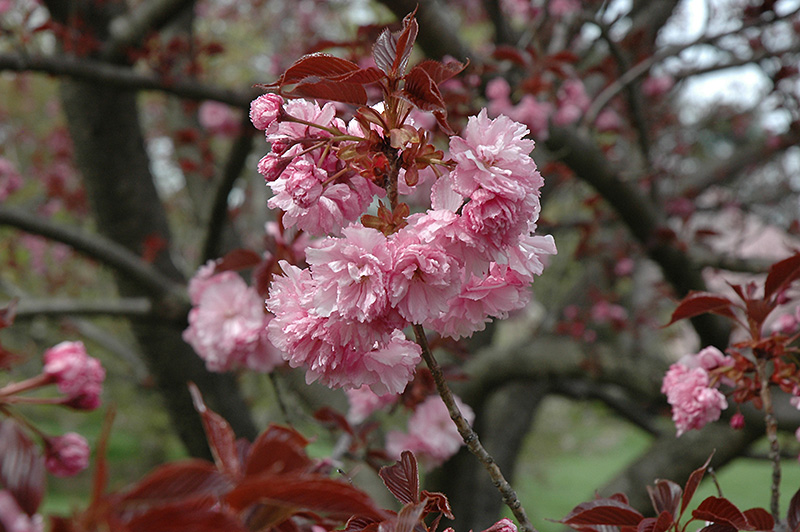Cherry, Flowering Royal Burgundy Prunus serrulata 'Royal Burgundy' Height: 30 feet Spread: 20 feet
Sunlight:
Hardiness Zone: 5a Other Names: Oriental Cherry, Japanese Cherry Description: An exciting new variety of flowering cherry, with pretty double reddish-pink flowers emerging along with the burgundy leaves in early spring which fade to green in summer, bronze bark, good fall color, very shapely; needs full sun and well-drained soil Ornamental Features Cherry, Flowering Royal Burgundy is covered in stunning clusters of cherry red flowers along the branches in early spring, which emerge from distinctive ruby-red flower buds before the leaves. It has attractive deep purple-tipped dark green foliage which emerges burgundy in spring. The serrated pointy leaves are highly ornamental and turn an outstanding orange in the fall. The smooth dark red bark adds an interesting dimension to the landscape. Landscape Attributes Cherry, Flowering Royal Burgundy is a deciduous tree with an upright spreading habit of growth. Its average texture blends into the landscape, but can be balanced by one or two finer or coarser trees or shrubs for an effective composition. This is a relatively low maintenance tree, and is best pruned in late winter once the threat of extreme cold has passed. It is a good choice for attracting birds and bees to your yard. It has no significant negative characteristics. Cherry, Flowering Royal Burgundy is recommended for the following landscape applications; Planting & Growing Cherry, Flowering Royal Burgundy will grow to be about 30 feet tall at maturity, with a spread of 20 feet. It has a high canopy of foliage that sits well above the ground, and is suitable for planting under power lines. As it matures, the lower branches of this tree can be strategically removed to create a high enough canopy to support unobstructed human traffic underneath. It grows at a medium rate, and under ideal conditions can be expected to live for 50 years or more. This tree should only be grown in full sunlight. It does best in average to evenly moist conditions, but will not tolerate standing water. This plant should be periodically fertilized throughout the active growing season with a specially-formulated acidic fertilizer. It is not particular as to soil pH, but grows best in rich soils. It is highly tolerant of urban pollution and will even thrive in inner city environments, and will benefit from being planted in a relatively sheltered location. This is a selected variety of a species not originally from North America. Special Attributes The flowering cherry trees flower before they leaf out. generally don't produce fruit because the frost kills the blooms, but if they do fruit they would be a few 1/4 inch purple cherries mostly the pit.![]()
![]()
![]()
![]()
![]()
![]()
![]()
![]()
![]()
![]()
![]()
![]()
![]()


